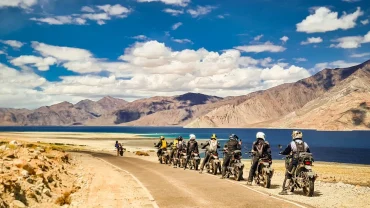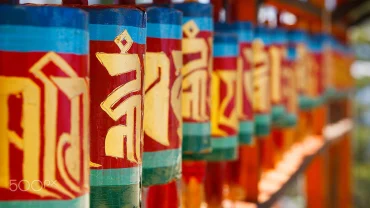I love everything about the winters—from snow-clad mountains to comfort food and the fantastic colorful clothing that look just amazing during that time. Ever since I was little, I would pester my parents to take me to the mountains during the wintertime to see snowfall and make snowmen—just like I saw in the movies. Little did I know that what I thought about winters would completely change once I visited the Spiti valley in the wintertime.
I’ve been fortunate to experience winters and snowfall in many areas worldwide, especially in Europe. The experience of travelling to Europe in the winter or being there throughout the winter season to see everything covered in a blanket of snow is nothing short of a dream. And just when I thought I had seen it all—including the northern lights and snow-covered peaks, Spiti came along to change it all.
Imagine a stark, desolate landscape covered with a veil of snow as far as the eye can see. Imagine looking outside your window and coming face-to-face with a snow leopard. Imagine temperatures several degrees below freezing—with a howling gale that never seems to give up! This is Spiti—the home of the hardworking people who inhabit this “middle land”.

Don’t get me wrong here, Spiti is stunning in every season—with lush green fields nestled among barren mountains and pristine blue waters of the Spiti river that flow from dozen-mile long glaciers that resemble scenes from Nat Geo and Discovery channel at every turn, you can never go back unhappy from a trip to Spiti. However, winters are when this land completely transforms into a different world altogether.
What is so different about Spiti in the winters?
Don’t take my word for it. You have to see it to believe it. My first visit to Spiti in the winter left me spellbound. It was mid-January, and my guide told me that it was the best time to come. We started from Chandigarh in my 4×4 Thar and I had snow chains along. The road is primarily uneventful until Reckong Peo, where it gets quite chilly and you can see decent amounts of snow. However, the real magic begins once you cross the bridge at Khab.
One turn, and for a moment, I thought I was witnessing a scene from the game of thrones, just in real life! Cold, stark, desolate—yet beautiful in a way that words cannot describe. Crossing the Kagiz at 8 degrees below zero was an experience that I will never forget.

How did my trip go?
Before I tell you about my trip, I think it is best if I describe my route and how I got to Spiti in the first place. I went on an 8-day trip to Spiti with Planet Way Round. Although I could have easily done this trip on my own, the problems I faced during the trip made me realize that it is essential to be with an experienced tour company that knows what to do when something goes wrong. Also, I had the privilege to be with a group that was open to switching hotels on demand. We stayed at a lot of homestays and enjoyed our trip to the fullest!
Here’s my Spiti itinerary:
- Day 1: Chandigarh to Theog
This was the most uneventful part of the trip. We took the Chandigarh-Chail-Kufri-Narkanda route and I am so glad we did! We hit our first patch of snow about 5km before Chail. After that, we drove through pristine forestland on this amazing route until we reached Kufri with its usual deluge of tourists. We saw lush green forests, loads of snow and had tea on the roadside made on portable stoves we carried along. It was a hoot! We stayed at The Exotic Resent in near the small hill town of Theog.
- Day 2: Theog to Kalpa
I woke up very early (6 am), had tea and what a morning it was it has snowed last night and our cars were covered in snow! what a way to start the day. I got the snow chains up on my Thar as there was more than a feet of snow on the road and what a drive it was till Narkanda. It was a beautiful, sunny, clear day and we enjoyed the rest of our trip through the well-known cantilevered road till Kinnaur. It was horrendously cold at the daytime (around -4), but we enjoyed our drive and our time on the road a lot. We stayed at the Grand Shambala in Kalpa for the night as it was freezing (-10) by the time we got there.
- Day 3: Kalpa to Kaza via Chango
This was the highlight of the trip. We started around 8 am as advised by the Planet Way Round team and had to again put on the snow chains as it had snowed a lot during the night. The moment we crossed Pooh, everything changed! Glaciers dotted the sides of the roads, and we were soon driving through foot-high snow in sub-zero temperatures. I saw my first frozen waterfall near Khab. The snow got deeper as we slowly trudged through the switchbacks on our way to Nako and finally reached Nako around 2 PM. It was sunny, but the moment I opened the door, I felt this blast of icy wind that made me get back in. I gathered all the courage I could muster and walked to the frozen Nako lake. I got back in exactly 20 minutes, and we went onwards to Kaza via Tabo. We reached Kaza around 7 pm after witnessing the amazing views from the Dhankar monastery. It was hellishly cold (-12C) and very windy. We quickly went into our homestay and were greeted with piping hot tea and local bread. The rest of the night was spent catching up with the rest of the group next to the Bukhari and discussing our day.
- Day 4: Local sightseeing
I woke around 7:30. and quickly made my way down to the dining room that had two big Bukhari to keep it warm. We started our sightseeing around 9 am and we went to the local monastery first, and then our guide asked us if we were game to see the Key monastery. I jumped and said yes, so our small group made our way up to Key.
The Key monastery is on a spur close to Kaza. The moment you take the road to Key and see the monastery in the distance, it is a view to behold! The whole scene looks as if you’re looking at a movie set. We went to the monastery and then onwards to the Chicham Bridge. We spent the rest of the day looking at other places around the area and went back to our homestay around 4. It was already -19 at that time, and we decided to call it a night around 8.
- Day 5: Extra day in Kaza and stay at Kibber
The entire group decided to stay an extra day in Kibber. We went to see the snow leopard’s habitat at Kibber, 19km from Kaza. The villagers told us that this activity was not permissible anymore, but we could roam around the village if we felt like it. I was crestfallen! I couldn’t hire a guide to see a snow leopard, but I understood the reasons behind it and decided to call it a day. We went on a hike with some local guides and stayed the night in a local homestay that introduced us to local customs, culture and food. This was the most amazing day of my stay in Spiti. I hiked, made a snowman and experienced local food and culture like never before!

- Day 6: Kaza to Sangla
We were ready to leave around 7:30 from Kibber, and I got into my car to realize that my battery was dead. Fortunately, we got a replacement through our tour guide and were soon on our way. 20km later, my snow chain came off. We spent about 10 minutes looking for it but then decided to put a new one on thanks to my tour guide. We reached Sangla around 4 pm. The drive was amazing and uneventful except the two problems my car had.
Important: This is why I suggest going to Spiti in the winter with a group. These two breakdowns would have left me stranded with no way to get help from anyone. With the help of their mechanic who accompanied us throughout the tour and the spares they kept along, I was able to complete my trip without (too many) hiccups.
- Day 7: Sangla to Rampur
The next day we went to the beautiful village of Chitkul, the drive took us through some amazing views with the baspa river flowing down in the valley and pristine snow covered mountains on both sides. After the visit we drove off to Rampur. We reached Rampur around 5pm. It was pretty warm in Rampur, around 8 degrees ( much warmer than -19 in Kaza ) when we got there.
- Day 8: Rampur – Chandigarh
This was the last day of our trip and an uneventful drive from Rampur to Chandigarh.
What did I do in my winter trip to Spiti?
A lot! Now I love to trek, do some amateur wildlife photography, understand new cultures and traditions and of course, make snowmen when it has just snowed! I did all of that and much, much more! I drove through knee-deep snow for dozens of kilometers, I survived hiking in temperatures several degrees below zero (-20 was the lowest we encountered at Kibber) and had so much fun that it took me a week to realize that I was already back home.
Final thoughts
Travelling to Spiti is an experience like non-other. You will see endless amounts of snow stretching as far as the eye can see. You will see frozen rivers, lakes and waterfalls. Who knows, you might even catch a glimpse of the elusive snow leopard on your way! However, before you jump off your seat and start driving to Spiti, understand that it gets bitterly cold—up to minus 30 degrees at night or lower. Daytime temperatures at Kaza were around -7 to -12 degrees. Ensure that you are fit, of sound health, and willing to follow your tour guide’s instructions. If you’re travelling to Spiti in the winter, check out this amazing blog post by our team. They listed out everything you need to do when planning the perfect winter vacation! The rest—Spiti will give you an experience that you will remember for a lifetime! If I had it my way, I would go here again—year after year!





Comment (0)